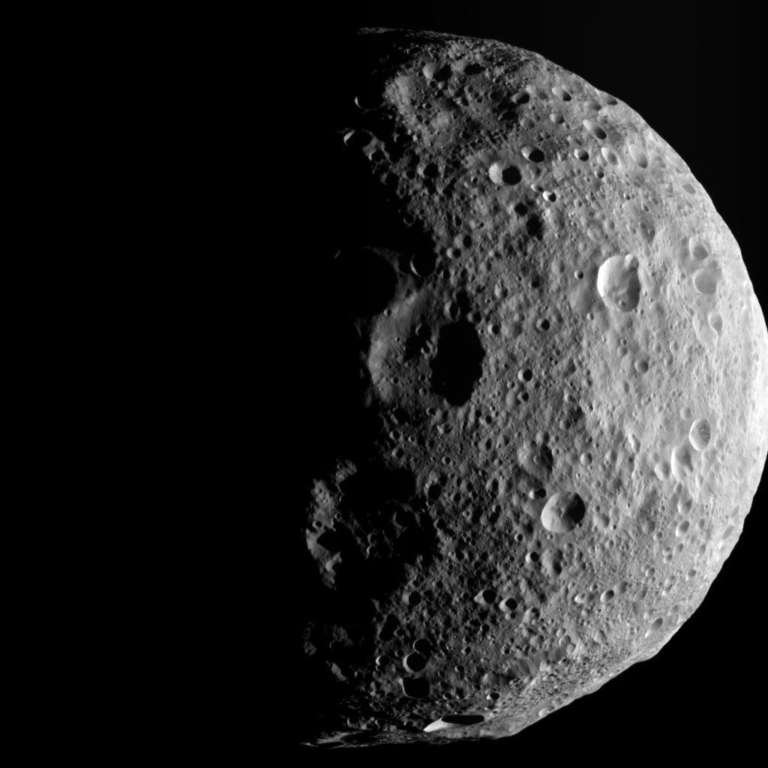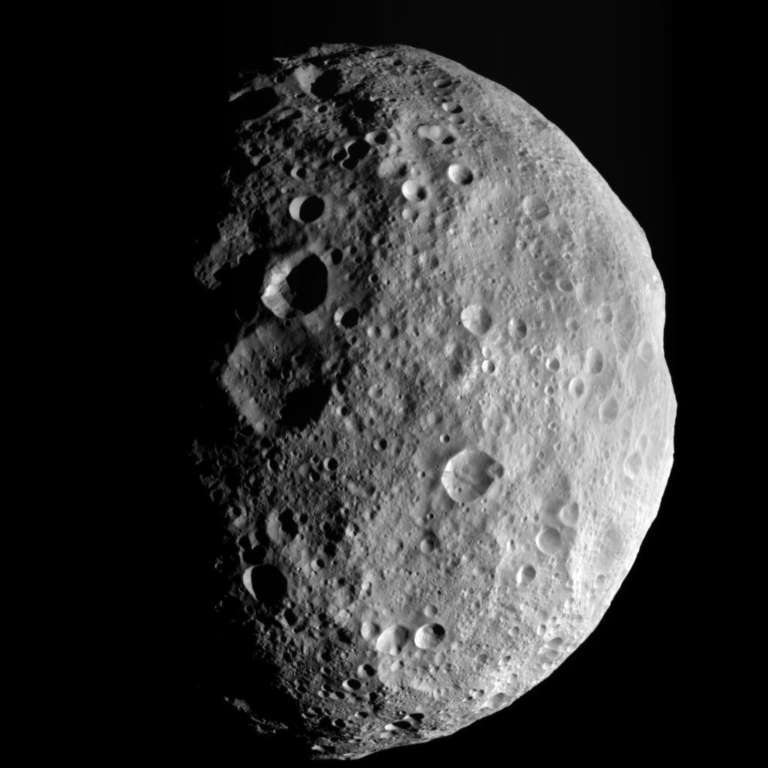Marc Rayman • Sep 06, 2012
Dawn Journal: Back to interplanetary space
Dear Marvestalous Readers,
An interplanetary spaceship left Earth in 2007. Propelling itself gently and patiently through the solar system with a blue-green beam of xenon ions, it gradually spiraled away from the sun. It sailed past Mars in 2009, its sights set on more distant and exotic destinations. In July 2011, it gracefully and elegantly entered orbit around the second most massive resident of the main asteroid belt, Vesta. It spent more than 13 months there scrutinizing the gigantic protoplanet with all of its sensors and maneuvering to different orbits to optimize its investigations, making myriad marvelous discoveries. After they traveled together around the sun for 685 million kilometers (426 million miles), the ship left orbit in September 2012 and is now headed for dwarf planet Ceres, the largest body between the sun and Neptune not yet visited by a spacecraft. No other probe has ever been capable of the amazing feats Dawn is performing, exploring two of the largest uncharted worlds in the inner solar system.

The population of the main asteroid belt numbers in the millions. Vesta is such a behemoth that Dawn has now single-handedly examined about eight percent of the mass of the entire belt. And by the time it finishes at the colossus Ceres, it will have investigated around 40 percent.
The expedition to Vesta has produced riches beyond everyone's hopes. With 31,000 photos, 20 million visible and infrared spectra, and thousands of hours of neutron spectra, gamma ray spectra, and gravity measurements, Dawn has revealed to humankind a unique and fascinating member of the solar system family. More akin to Earth and the other terrestrial planets than to typical asteroids, Vesta is not just another chunk of rock. It displays complex geology and even has a dense iron-nickel core, a mantle, and a crust. Its heavily cratered northern hemisphere tells the story of more than 4.5 billion years of battering in the rough and tumble asteroid belt. Its southern hemisphere was wiped clean, resurfaced by an enormous impact at least two billion years ago and an even greater collision one billion years ago. These events excavated the 400-kilometer (250-mile) Veneneia and 500-kilometer (310-mile) Rheasilvia basins. The larger basin has a mountain at the center that towers more than twice the height of Mt. Everest; indeed, it soars higher than all but one of the mountains known in the solar system. The impacts were so forceful, they nearly destroyed Vesta. The fierce shock reverberated through the entire body and left as scars an extraordinary network of vast troughs near the equator, some hundreds of kilometers (miles) long and 15 kilometers (10 miles) wide.
The powerful impacts liberated tremendous amounts of material, flinging rocks far out into space, some of which eventually made it all the way to Earth. It is astonishing that more than one thousand of the meteorites found here came from Vesta. We have some meteorites from Mars, and we have some meteorites from the moon, but we have far, far more that originated in those impacts at Vesta, so distant in time and space. Vesta, Mars, and the moon are the only celestial bodies identified as the source of specific meteorites.
Scientists will spend years productively poring through Dawn's fabulous findings and learning what secrets they hold about the dawn of the solar system, and many more people will continue to marvel at the spectacular sights of this alien world. But the emissary from Earth has completed its assignment there and moved on. It has spent most of its time since the previous log using its ion propulsion system to climb higher and higher above Vesta. This departure spiral is the mirror image of the approach spiral the robotic adventurer followed last year. The unique method of entering and leaving orbit is one of the many intriguing characteristics of a mission that uses ion propulsion. Without that advanced technology, this ambitious deep space adventure would be impossible.
As Dawn ascended, Vesta's gravitational grip grew weaker and weaker. At some point along its spiral, the explorer was far enough and moving fast enough that Vesta could no longer hold it in orbit. As smoothly and tenderly as Vesta had taken Dawn in its embrace last year, it released its erstwhile companion, each to go its own way around the sun. The bond was severed at about 11:26 p.m. PDT yesterday, when they were 17,200 kilometers (10,700 miles) apart, separating at the remarkably leisurely speed of less than 33 meters per second (73 miles per hour). Many of our readers drove their cars that fast today (although we hope it was not in school zones).
Unlike missions that use conventional chemical propulsion, there was no sudden change on the spacecraft and no nail-biting on Earth. If you had been in space watching the action, you probably would have been hungry, cold, and hypoxic, but you would not have noticed anything unusual about the scene. Apart from a possible hint of self-satisfaction, Dawn would have looked just as it had for most of its interplanetary flight, a monument to humankind's ingenuity and passionate drive to know the cosmos perched atop a blue-green pillar of xenon ions. If, instead, you had been in Dawn mission control watching the action, you would have been in the dark and all alone (until JPL Security arrived). There was no need to have radio contact with the reliable spaceship. It had already thrust for almost 2.9 years, or 58 percent of its time in space. Thrusting during escape was no different. No one was tense or anxious; rather, all the drama is in the spectacular results of the bold mission at Vesta and the promise of what is to come at Ceres. When Dawn entered orbit, your correspondent was dancing. When Dawn left orbit, he was sleeping serenely [Webmaster: please link "sleeping serenely" to the site containing the detailed records of my dreams].
A month earlier, on August 8, with the craft more than 2,100 kilometers (1,300 miles) above the surface, patiently powering its way up through Vesta's gravity field, one of the reaction wheels experienced an increase in internal friction. Reaction wheels are used to control a spacecraft's orientation in the frictionless, zero-gravity conditions of spaceflight. By electrically changing a wheel's spin rate, Dawn can rotate or stabilize itself. Protective software quickly detected the event and correctly responded by deactivating that wheel and the other two that were operating, switching to the small jets that are available for the same function, and reconfiguring other systems, including powering off the ion thrust and turning to point the main antenna to Earth.
A routine communications session the next day revealed to mission controllers what had occurred. They had planned long ago to turn the wheels off for the flight from Vesta to Ceres, so having them off a few weeks early was not a significant change. The team soon restored the spacecraft to normal operations and reformulated the departure plan, and on August 17 Dawn resumed its ascent. Because of the hiatus in thrusting, escape shifted from August 26 to September 4. The flexibility in the mission timeline provided by ion propulsion made this delay easy to accommodate.
In order to conserve the hydrazine propellant that the jets use, the bonus departure observations described before were curtailed, as they were not a high priority for the mission. Nevertheless, on August 25 and 26, at an altitude of around 6,000 kilometers (3,700 miles), the explorer did peer at Vesta once more with its camera and visible and infrared mapping spectrometer. The last time it had been this far away was July 21, 2011, during its descent to an unfamiliar destination. This time, 13 months later, the spacecraft turned back for a final gaze at the magnificent world it had unveiled during its remarkable time there, a world that prior to last year had appeared as little more than a tiny smudge among the stars for the two centuries it had been observed.
The delay in the departure schedule provided a convenient benefit. Vesta has seasons, just as Earth does, although they progress more slowly on that distant orb. August 20 was the equinox, when northern hemisphere spring began. Until then, the sun had been in Vesta's southern hemisphere throughout Dawn's residence there. While most of the northern hemisphere was revealed during the second high-altitude mapping orbit, the illumination of the landscape immediately around the north pole was even better for this last look. After radioing its parting shots to wistful mission controllers, the ship commenced its climb again.
And then, with an stunningly successful mission behind it, a newly explored world below it, and a mysterious dwarf planet ahead of it, the indomitable and indefatigable adventurer left Vesta forever.

Dawn is 18,500 kilometers (11,500 miles) from Vesta and 64 million kilometers (40 million miles) from Ceres. It is also 2.45 AU (367 million kilometers or 228 million miles) from Earth, or 910 times as far as the moon and 2.43 times as far as the sun today. Radio signals, traveling at the universal limit of the speed of light, take 41 minutes to make the round trip.
Dr. Marc D. Rayman
10:00 a.m. PDT September 5, 2012
Support our core enterprises
Your support powers our mission to explore worlds, find life, and defend Earth. You make all the difference when you make a gift. Give today!
Donate

 Explore Worlds
Explore Worlds Find Life
Find Life Defend Earth
Defend Earth

